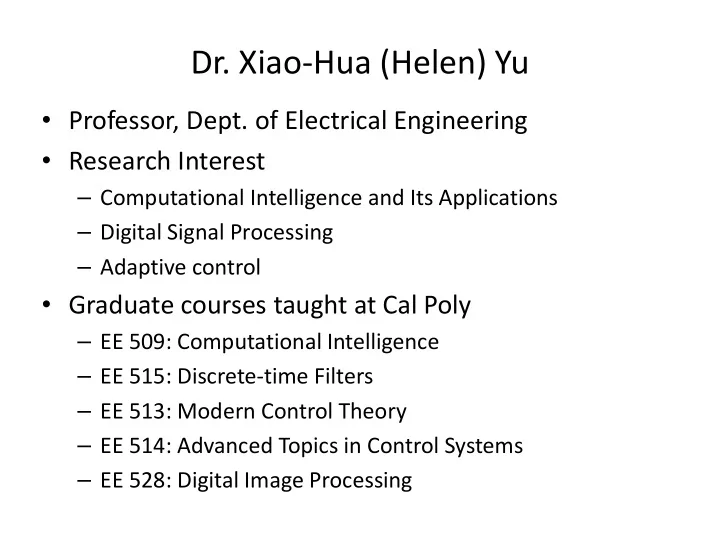

Dr. Xiao-Hua (Helen) Yu • Professor, Dept. of Electrical Engineering • Research Interest – Computational Intelligence and Its Applications – Digital Signal Processing – Adaptive control • Graduate courses taught at Cal Poly – EE 509: Computational Intelligence – EE 515: Discrete-time Filters – EE 513: Modern Control Theory – EE 514: Advanced Topics in Control Systems – EE 528: Digital Image Processing
Computational Intelligence • Applications • Areas of study – System identification – Artificial neural networks – Adaptive control – Evolutionary computation – Signal processing – Swarm intelligence – Optimization – Immuno-computation – And many more…
Computational Intelligence Applications
Current Projects • Biomed signal/image processing, medical diagnosis, and biometrics identification with deep learning and various intelligent paradigms – ECG and EEG signals – Medical image registration – Alzheimer’s disease detection • Smart power grid – Electricity price prediction – Fault detection and classification • Control system applications – Robot path planning – Decentralized multi-robot formation control – Reinforcement learning for controller design • Other AI related applications…
Motor Imagery Classification • Electroencephalography (EEG) is commonly used to study brain cortical electrophysiology – It is reported that approximately 20 million people in the United States suffer from irreversible nerve damage – Neuroprosthetic devices with Brain Computer Interface (BCI) have become a viable solution for paralysis patients in recent years • With EEG signal analysis, these systems can interpret (translate) human brain activities into commands to control artificial limbs or robot arms for patients • Various approaches based on computational intelligence will be studied
Image Registration • In clinic studies, multiple images for a patient are usually acquired at different time to allow doctors to monitor the effects of treatment over time • However, it is usually difficult to have the region of interest (e.g. a tumor) positioned in exactly the same spot or orientation for multiple images • Image registration transforms different sets of data into one coordinate system in order to align up and overlay multiple images • Our approach considers both image and frequency domain features
Alzheimer’s Disease Detection • Alzheimer’s disease is a chronic neurodegenerative disease that results in progressive cognitive decline and eventually leads to dementia – It is the 6th leading cause of death in US. Early detection is crucial for symptom management and treatment • Brain scan images (CT, MRI, PET, etc.) are often used to detect Alzheimer’s disease – Electroencephalogram (EEG) can also be used to detect abnormal brain-wave activity • Artificial neural networks (ANN) and deep learning provide an intelligent way for analysis
Robot Path Planning • Advanced Optimization Algorithm for Robot Path Planning – Path planning is an essential task for the navigation and motion control of autonomous robot manipulators – A difficult task especially in the situation that the optimal path needs to be rerouted in real-time when a new obstacle appears – Biologically inspired methods such as swarm intelligence and advanced search algorithms can be applied to find the best route for autonomous robots in a dynamic environment
Control Systems Applications • Collective movement for multi-robots – Decentralized multi-robot formation control – Social robots • System Identification – A “non-parametric” approach with no or less a priori knowledge of the system dynamics • Reinforcement learning – Inspired by natural learning mechanisms, where animals adjust their actions based on reward and punishment stimuli received (the “cause-and- effect” relationship) – A system that can improve its performance based on the results of previous actions
Electricity Price Prediction • In electricity market, electricity is a commodity that can be bought, sold, and traded – Electricity is, by its nature, usually difficult to store and has to be available on demand – Power system stability requires a constant balance between production and consumption – Electricity demand depends on many factors such as weather conditions, daily activities (e.g. peak-hours), etc. – The goal is to develop an intelligent model to predict electricity price
Power System Fault Detection & Classification • Monitoring the performance of power network automatically is an important component of modern “smart grid ” – A single fault, even when lasting only for a fraction of a second, may affect potentially millions of customers on the grid and result in huge losses and manufacturing downtime in industry – These power quality events (PQEs) can be caused by natural disasters, equipment failures, or human errors No fault Fault #2 Fault #1
Need More Information? • Contact Dr. Yu for more project information xhyu@calpoly.edu • Some programming skills are preferred (any language is OK) • Other projects may also be available upon request and discussion. You are also welcome to propose your own ideas
Recommend
More recommend